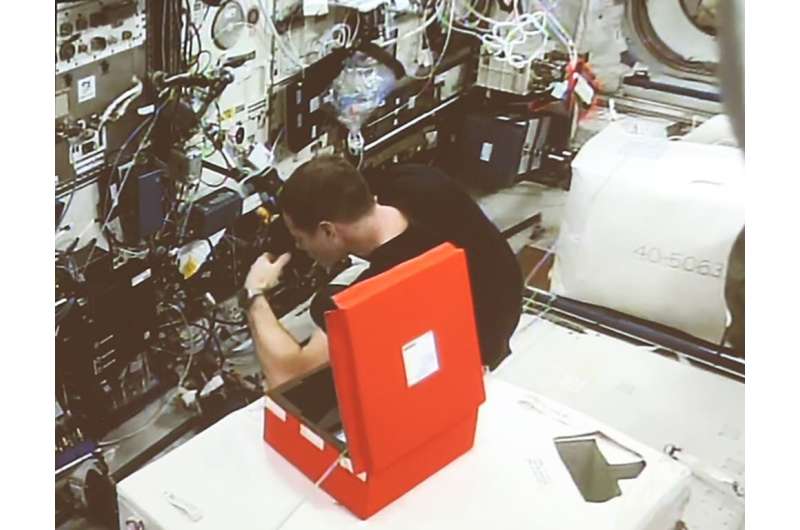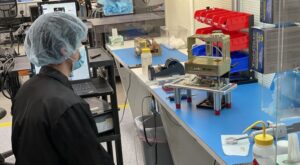China's Mars rover soldiers on after completing program
Saturday, 21 August 2021 07:10
China's Zhurong Mars rover is soldiering on after completing its initial program to explore the red planet and search for frozen water that could provide clues as to whether it once supported life.
China's National Space Administration said on its website Friday that Zhurong completed its 90-day program on Aug. 15 and was in excellent technical condition and fully charged.
It said it would continue to explore the area known as Utopia Planitia where it landed on May 14. Zhurong has been consistently sending back photos and data via the Tianwen-1 orbiter that crosses over it once a day.
After the United States, China is the second country to land and sustainably operate a spacecraft on Mars, where days are 40 minutes longer than on Earth.
At 1.85 meters (6 feet) in height, Zhurong is significantly smaller than the American Perseverance rover, which is exploring the planet with a tiny helicopter. NASA expects its rover to collect its first sample in July for return to Earth as early as 2031.
Concurrently, China is assembling its permanent space station, with three astronauts now aboard the Tianhe, or Heavenly Harmony, core that was put into orbit on April 29.
Op-ed | Unlocking New Economic Frontiers in Space
Saturday, 21 August 2021 05:42
More than space tourists, Jeff Bezos and Richard Branson are leading the way to commercial and public utilization of space previously only imagined in science fiction.
Op-ed | Space tourism’s environmental price tag
Saturday, 21 August 2021 05:40
There’s no such thing as a free launch — especially when it comes to suborbital joy rides.
Shareholders approve Rocket Lab SPAC deal
Friday, 20 August 2021 22:18
Shareholders of a special-purpose acquisition company (SPAC) voted Aug. 20 to merge with Rocket Lab, giving the small launch vehicle and spacecraft developer an infusion of cash.
Here comes the sun: Planetary scientists find evidence of solar-driven change on the moon
Friday, 20 August 2021 19:56
Tiny iron nanoparticles unlike any found naturally on Earth are nearly everywhere on the moon—and scientists are trying to understand why. A new study led by Northern Arizona University doctoral candidate Christian J. Tai Udovicic, in collaboration with associate professor Christopher Edwards, both of NAU's Department of Astronomy and Planetary Science, uncovered important clues to help understand the surprisingly active lunar surface. In an article recently published in Geophysical Research Letters, the scientists found that solar radiation could be a more important source of lunar iron nanoparticles than previously thought.
Asteroid impacts and solar radiation affect the moon in unique ways because it lacks the protective magnetic field and atmosphere that protect us here on Earth. Both asteroids and solar radiation break down lunar rocks and soil, forming iron nanoparticles (some smaller, some larger) that are detectable from instruments on satellites orbiting the moon. The study used data from National Aeronautics and Space Administration (NASA) and Japan Aerospace Exploration Agency (JAXA) spacecraft to understand how quickly iron nanoparticles form on the moon over time.
"We have thought for a long time that the solar wind has a small effect on lunar surface evolution, when in fact it may be the most important process producing iron nanoparticles," Tai Udovicic said.
Foust Forward | A schedule better suited for Artemis
Friday, 20 August 2021 17:15
While moving up the date of a human lunar landing may have been well intentioned, providing the urgency needed to make decisions and more forward, budgets that have not kept pace with projections and inevitable future technical problems make it unlikely NASA can get everything in place to land humans on the moon in 2024.
Space Force to establish new command in Colorado focused on training and education
Friday, 20 August 2021 17:13
The U.S. Space Force on Aug. 23 will establish the Space Training and Readiness Command at Peterson Space Force Base in Colorado Springs.
Radiation-detecting optical fibers installed on the International Space Station
Friday, 20 August 2021 14:26
In a spacecraft, in order to protect both crew and electronics from radiation, it is mandatory to invest in effective radiation monitoring systems. The International Space Station (ISS), just like the Large Hadron Collider at CERN, is a complex radiation environment that requires bespoke dosimetry devices. Optical-fiber-based technologies can provide both distributed and point radiation dose measurements with high precision.
On 18 August, ESA astronaut Thomas Pesquet activated the Lumina experiment inside the ISS as part of the ALPHA mission. Developed under the coordination of the French Space Agency, CNES, and with the involvement of CERN, the Laboratoire Hubert Curien at the Université Jean-Monnet-Saint-Étienne, and iXblue, this project uses two several-kilometer-long optical fibers as active dosimeters to measure ionizing radiation in the ISS with very high sensitivity.
Op-ed | Private industry spacesuit advancements are the solution to OIG report findings
Friday, 20 August 2021 14:17
The recent Office of Inspector General report that concluded NASA's spacesuit program is out of sync with with a 2024 lunar landing excluded any consideration of the substantial privately led work that has already been accomplished by industry.
PNT alternatives champion open-market approach
Friday, 20 August 2021 13:47
Competing positioning, navigation, and timing (PNT) companies are joining forces to accelerate efforts to back up global navigation satellite systems (GNSS).
Space Force awards $32 million in contracts to startups and small businesses
Friday, 20 August 2021 12:27
At a virtual pitch event Aug. 19, the U.S. Space Force selected 19 companies that each will receive $1.7 million Small Business Innovation Research Phase 2 contracts.
Week in images: 16 - 20 August 2021
Friday, 20 August 2021 12:15
Week in images: 16 - 20 August 2021
Discover our week through the lens
Musk hopes "Mechazilla" will catch and assemble the Starship and Super Heavy boosters for rapid reuse
Friday, 20 August 2021 10:25
In January of 2021, Elon Musk announced SpaceX's latest plan to increase the number of flights they can mount by drastically reducing turnaround time. The key to this was a new launch tower that would "catch" first stage boosters after they return to Earth. This would forego the need to install landing legs on future Super Heavy boosters and potentially future Starship returning to Earth.
Musk shared this idea in response to a tweet made by an animator who goes by the Twitter handle Erc X, who asked if his latest render (of a Starship landing next to its launch tower) was accurate. As usual, Musk responded via Twitter, saying:
"We're going to try to catch the Super Heavy Booster with the launch tower arm, using the grid fins to take the load… Saves mass & cost of legs & enables immediate repositioning of booster on to launch mount—ready to refly in under an hour."
Mechazilla #SpaceX#Starship@elonmuskpic.twitter.com/0hUWHj1BKe
— Erc X (@ErcXspace) August 13, 2021
The ground crews at SpaceX's South Texas Launch Facility near Boca Chica recently finished stacking the nine sections of bolted steel that make up the tower, which now stands about 145 m (440 ft) tall.
A-74 iceberg near collision with Brunt Ice Shelf
Friday, 20 August 2021 09:15 Image:
New radar images show the A-74 iceberg spinning around the western tip of the Brunt Ice Shelf, brushing slightly against it before continuing southwards.
Image:
New radar images show the A-74 iceberg spinning around the western tip of the Brunt Ice Shelf, brushing slightly against it before continuing southwards. Comet Atlas may have been a blast from the past
Friday, 20 August 2021 08:30 However, this nameless space visitor is not recorded in any known historical account. So how do astronomers know that there was such an interplanetary intruder?
Enter comet ATLAS (C/2019 Y4), which first appeared near the beginning of 2020. Comet ATLAS, first detected by the Asteroid Terrestrial-impact Last Alert System (ATLAS), operated by the University of Hawaii, quickly met an untimely
However, this nameless space visitor is not recorded in any known historical account. So how do astronomers know that there was such an interplanetary intruder?
Enter comet ATLAS (C/2019 Y4), which first appeared near the beginning of 2020. Comet ATLAS, first detected by the Asteroid Terrestrial-impact Last Alert System (ATLAS), operated by the University of Hawaii, quickly met an untimely 
